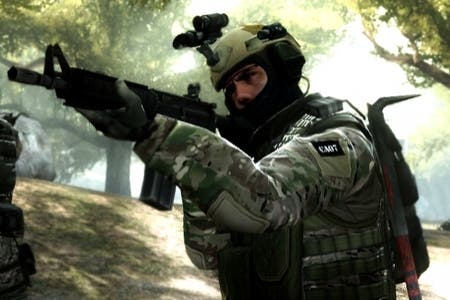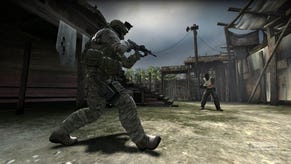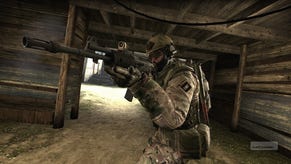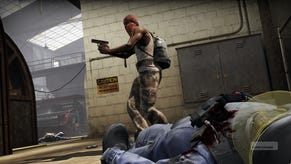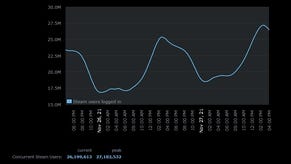Face-Off: Counter-Strike: Global Offensive
Source code.
| - | Xbox 360 | PlayStation 3 |
|---|---|---|
| Disc Size | N/A | N/A |
| Install | 2.0GB | 2302MB |
| Surround Support | Dolby Digital | Dolby Digital |
Over 13 years after Counter-Strike first appeared as a user-created mod for the original Half-Life, the game is still one of the most popular shooters available on Steam. So much so that despite the release of Counter-Strike Source back in 2004, the 1.6 version of the original game is still supported by a sizeable number of dedicated players. The driving force behind the game's popularity is simple: the team-based gameplay works just as well now as it did all those years ago and, remarkably, it still delivers an experience which comfortably stands out from other first-person shooters in today's crowded marketplace.
Global Offensive marks the first attempt at updating the series for a new audience. Once again powered by Valve's ageing Source engine, this latest version of Counter-Strike brings with it two new game modes more suited for gamers used to today's online first-person shooters, along with a complete graphical overhaul, including new textures, enhanced lighting, and upgraded environment modelling. While there's no mistaking Global Offensive for a high-end current generation title, developer Hidden Path Entertainment has handed in a refined version of an old classic which looks pretty while containing a few modern visual enhancements that keep things feeling fresh.
The bulk of these graphical upgrades carry over nicely across multiple platforms, although we do see some variation with regards to visual effects and lighting between the consoles and PC release, along with a few anomalies in terms of texture detail. As with Portal 2, there have been a few tweaks made across the consoles, with both the 360 and PS3 getting their own plus point over each other - variations in lighting, effects and performance can be found. However, by far the biggest change compared to past Source engine titles comes with the anti-aliasing set-up on both consoles. Here's a head-to-head movie, backed of course with our usual triple-format comparison gallery.
"Variations in the post-process anti-aliasing solutions employed in Counter-Strike are the most noticeable difference between the two console versions of the game."
As we've come to expect from Source engine games running on console, Global Offensive renders natively in 720p, and similar to Portal 2, hardware-based anti-aliasing has been jettisoned in favour of a lower cost post-process solution to improve performance. Here we find both versions adopting slightly differing implementations of NVIDIA's FXAA algorithm on each platform. As a result, the baseline look of Global Offensive is very similar on both formats. The usual edge shimmering artifacts can be clearly seen on sub-pixel elements in various scenes along with some mild texture blurring that is an unfortunate side-effect of most current-gen console post-AA filters.
Depending on the lighting conditions and environment details we see that there is slightly less in the way of edge artifacts on the 360 game on some surfaces, although the improvement in this regard is very, very mild. Some edges get slightly better coverage mainly due to the difference in gamma set-ups, making this version appear darker. The volume of higher contrast edges is reduced, leading to a small, additional reduction in artifacts across geometry edges, although in truth the difference is very small. In some shots we actually see the PS3 version featuring better coverage on select edges, particularly on the trees in the Dust map. The impact of this is somewhat limited, and neither version has any real advantage here.
The gamma differences are more of an issue, tending to create dimmer looking scenes on the 360 which lack the same kind of dynamic range as seen on the PS3. On many occasions this additional darkness on 360 makes gives the appearance of missing light sources on the Microsoft platform, but this isn't always the case in every area, with the higher gamma curve dulling the impact of the lighting in darker parts of the game.
There are, however, some differences with regards to the lighting in both versions, which generally favour the PS3 version, giving it a warmer, more vibrant look. While light shafts and bloom are generally replicated identically on both formats, in some locations these features are missing on the 360, leaving the affected areas looking dimmer than the PS3 and PC games. Here we get the feeling that the altered lighting model takes away some of the vibrancy and dynamic range of the visuals seen in the other versions of the game. Although curiously, the difference in both gamma and lighting set-up has little effect in some areas, such as in the car park situated at the start of the Office map, in which all three versions appear almost identical.
"Varying gamma levels seem to reduce the impact of some lighting effects on the Xbox 360 version, while elsewhere other light sources seem to be entirely absent. Here, the PlayStation 3 more closely mirrors the PC game."
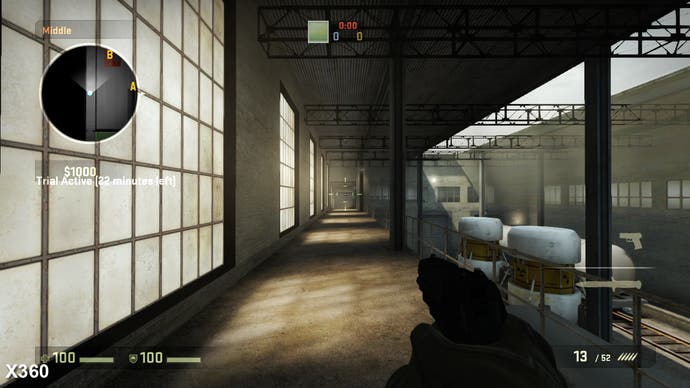

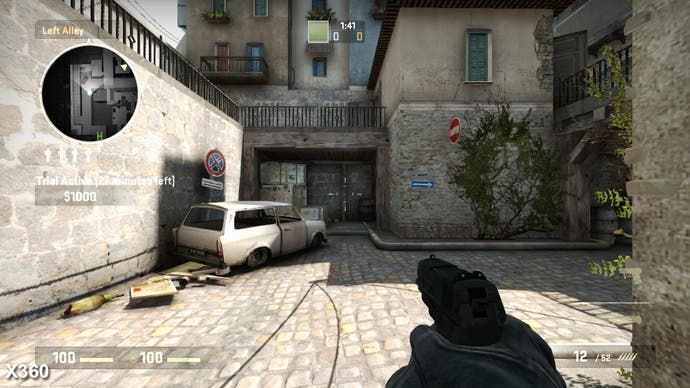
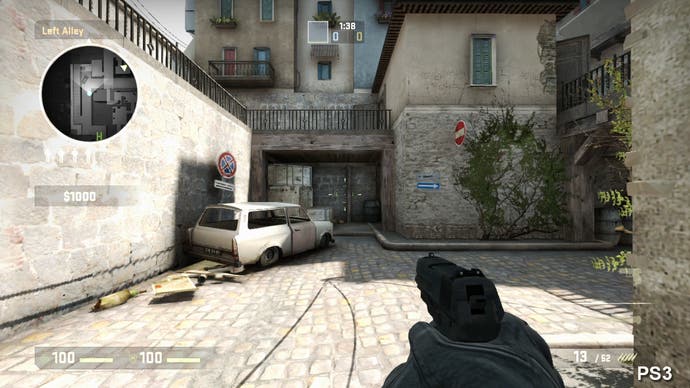
Texture detail and filtering is also a match on both formats, and this helps to hide some of the other differences we see throughout the game. Global Offensive features upgraded assets for the environment and characters over previous versions of Counter-Strike: higher resolution artwork is joined by some low quality texturing which heavily pixelates on closer inspection, though these are far more refined and detailed than seen in previous editions of the title. 8x anisotropic filtering (AF) also looks to be in play, so texture clarity is also preserved on distant objects and flat surfaces in relation to the camera.
The only difference we see in this area lies with the game's streaming system. While there doesn't appear to be any noticeable texture pop-in when running through the game's maps, we do see some clear LOD (level of detail) transitions with regards to the shadow maps on both platforms. These transitions occur later on the PS3 - causing changes to occur quite close to the camera - although are smoothly blended together so there are never any sudden jumps between quality levels. Shadows never pop out, instead smoothly fading in.
Shadow quality can be a mixed bag on both consoles, with PCF (percentage closer filtering) being employed to roughly filter the edges, but it's also clear that these elements of the game are rendered in much higher resolution on the 360. On the PS3 shadows do initially look smoother than on the 360 on some surfaces when they are far away from the player, but closer inspection reveals noticeable stair-step patterns across shadow edges, with some obvious shadow cascade transitions magnifying these artifacts. An off-set bias is also present, which sees these elements of the scene extend outwards further from their point of origin on the 360.
In other areas variances between both versions are harder to spot, although they do clearly manifest themselves when you go looking. For example, the muddy pools of water appear considerably murkier on the 360, featuring an additional surface layer over the PS3, along with extra environmental reflections. Owners of Microsoft's system basically get higher precision reflective effects and enhanced water shaders in a number of areas, such as on the stagnant pools of water in the Aztec stage.
"The Xbox 360 game has more advanced shaders in some areas and LOD transitions are markedly less aggressive than they are on the PlayStation 3."
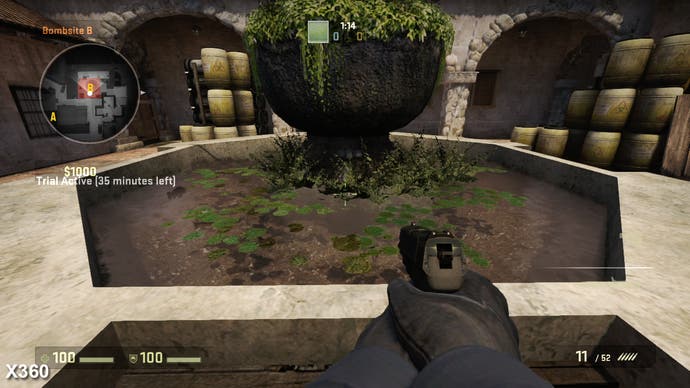
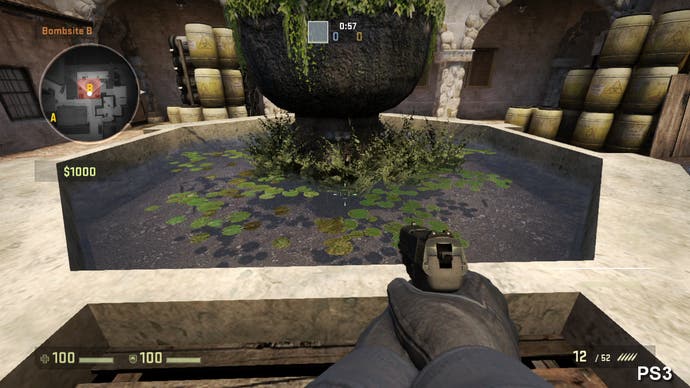

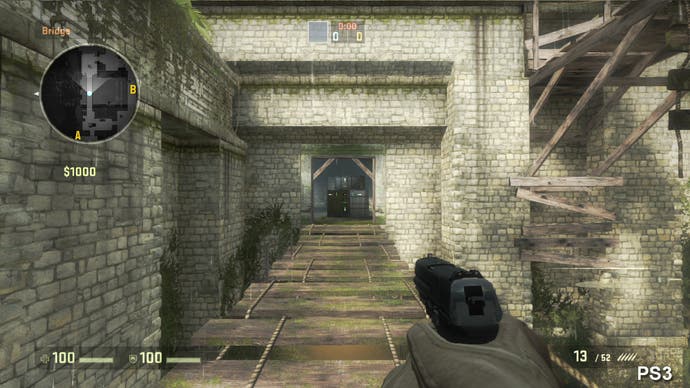
Thankfully, there are other areas of the game in which things are far more closely matched. Alpha buffers are rendered in full resolution on both platforms, with no signs of any unwanted edge artifacts when these elements of the scene intersect with the surrounding geometry. Some effects, such as grenade explosions, feature an extra layer of smoke on the 360 just after detonation, but the differences here are much too small to be noticed during play. Small touches - such as the gentle appearance of smoke after mild gunfire, or muzzle flashes lighting up the environment - are replicated on both platforms equally.
From a visual perspective then, the overall look of both games is very close. For the most part it's hard to tell each one apart from each other, except for in specific scenes in which we see changes in lighting and gamma. The use of lower precision/pared back effects work on some areas (such as on the pools of water) goes by completely unnoticed during a heated match, where there's simply no time to stand around and admire the game's well designed environments.
Global Offensive: Performance Analysis
As an online experience designed around high precision shooting in which every bullet counts, having a stable frame-rate with a limited amount of dips in performance is particularly important. Changes in controller latency can be very off-putting, impacting on a player's ability to aim and track opponents in fast-paced combat situations. As such, it is important to keep heavy frame-rate drops and intrusive screen tear fairly isolated from regular play.
Past Source engine games have always run smoothly on the 360 with a minimum amount of frame-rate drops and few issues with regards to tearing, so it's no surprise to learn that performance is very favourable in Global Offensive. Most matches we played can often go by without a single hitch; a consistent 30FPS is easily maintained and tearing is very rarely introduced. As the video below demonstrates, we're looking at a constant 30FPS, where the engine appears to be locked at the desired frame-rate unless it is being heavily pushed.
"Performance on the Xbox 360 version of Counter-Strike: Global Offensive is the standard 30 frames per second with just the odd issue with screen-tear in intense scenes."
The only time we really see things deviate from this smooth level of performance is when we are confronted by heavy alpha effects on screen - usually when fire is introduced via letting off an incendiary grenade or Molotov cocktail - in which case we see some tearing beginning to creep in along with a noticeable, although brief drop in frame-rate. The good news is that general explosions and heavy gunfire have little to no impact on how well the engine performs outside of these moments. It's only in more detailed environments with multiple players where smoothness becomes affected. So while we never get the more responsive set-up as seen on a fairly modest PC when running the game at 60FPS, we still get an experience which feels largely consistent throughout, without it being noticeably impacted by large and regular variances in controller latency or graphical slowdown.
However, despite the mostly stable 30FPS update, something doesn't feel quite right with the controls, the handshake between player and game feeling somewhat off-kilter. Tracking enemies accurately across the screen isn't as quick and responsive as you might expect in a title which is designed around precision shooting. Simply put, gameplay comes across as feeling a little heavy, even in offline mode where we can factor out any variances caused by slow broadband connections of other players.
Using a Ben Heck controller monitor board - as used by professionals like Infinity Ward and id software - we measured controller response times to be around 150ms across a general run of play. This is on a par with what we measured in Killzone 2 on the PS3 - a title in which many players complained about the amount of latency in the controls, and explains why things don't feel quite as responsive as we'd liked to see in a precision-based FPS. Things only worsen when the engine is put under stress, where we see frame-rates drop down to around the 24FPS mark for brief periods, and in these moments controller latency rises up to around the 183ms mark, putting it similar territory to cloud-based gaming services such as Gaikai and OnLive when smoothness is compromised.
Just like its console sibling, the PS3 version of Counter-Strike also targets a 30FPS update. However, it is often apparent when playing that the controls can be even less responsive than the Xbox 360 version during heated combat, with signs that the engine isn't coping quite as well in dealing with the rendering load where heavy gunfire is concerned. Controller response feels like it is a match for the 360 during times when the engine is outputting a solid 30 frames per second, but otherwise there appears to be a tangible increase in input lag when performance is affected. Venturing into more complex environments when there are multiple players on screen causes noticeable issues with tearing, in which we see torn frames manifest by moving up and down the middle of the screen, easily in full view of player. In these situations, even firing off a simple pistol causes small, but regular drops in frame-rate.
"PlayStation 3 Counter-Strike has a noticeably lower performance level than the Xbox 360 game, further adding to a game that already has a rather high level of input lag."
Elsewhere, heavy weapons fire also introduces both tearing and some noticeable drops in smoothness. Muzzle flashes seem to be the main cause here: when combined with smoke and flame effects during explosions and incendiary attacks, frame-rates can topple and controller responsiveness is tangibly reduced. In moments like these the game simply feels sluggish to play, and you aren't getting the kind of precision you'd require from this type of game. The problem we have here is that these dips in performance mostly manifest after the trigger has been pulled and unfortunately this does give the game a somewhat laggier response than the 360 version as a result.
However, the PS3 version clearly enjoys a clear advantage with regards to the number of control options available to the player. In particular, the ability to use a mouse and keyboard set-up allows you to gain a tangible increase in precision over the 360 game even factoring in the more uneven performance on offer. Adjusting your aim when frame-rates are falling and control is lagging is faster and easier with a mouse and certainly helps improve the overall experience.
On top of this, the PS3 version also supports the use of the Move and Navigation controller. Again, accuracy is certainly improved over the standard dual analogue set-up of the Dual Shock 3 pad, with headshots much easier to obtain. There's no additional lag we could detect using this method of input either, which should please those who prefer to game using motion controls. It's not perfect, however: there's a tendency for Move to confuse the game when performing various motions while aiming, and this causes some unusual things to happen, such as your viewpoint being turned around randomly as the game misreads the inputs being provided by the motion controller.
Counter-Strike on PC: The Best All-Round Experience?
Global Offensive on PC shares the same outdated source material as the 360 and PS3, but still leaves room for subtle graphical upgrades - and more importantly, a colossal boost in performance over console without needing cutting edge hardware. Source engine games always tend to run nicely across a range of hardware configurations, and this new title is no exception.
As usual, overall image quality is the defining factor in separating the PC release from the console SKUs, in addition to frame-rate. On the PC Global Offensive features a wide range of resolution and anti-aliasing options to suit a variety of configurations. We settled on 8x multi-sample anti-aliasing in combination with NVIDIA's FXAA in order to maximise image quality to its fullest extent.
The head-to-head video below should give you a good indication of how much cleaner the PC game looks over the PS3 game (360 mirror also included).
"As you would expect, for the most part, the PC version of Counter-Strike: Global Offensive comprehensively bests the console versions in terms of image quality."
The most obvious improvement over the console games comes with a clear reduction in the amount of aliasing on screen - it's practically non-existent. Power lines and other sub-pixel heavy objects are fully resolved without any noticeable break up as the camera moves away from these elements of the scene. Likewise, texture detail is further brought out to the surface, even on parts of the environment which feature console quality artwork, thus showing the added benefits of higher levels of edge-smoothing in helping to enhance the general look of the game.
On top of this, the FXAA solution in play also works a lot better with the sub-pixel details available: we never get the feeling that the extra dose of edge smoothing does any harm to the overall image at all - texture blur appears to be minimal and a high level of detail is maintain on surfaces which use higher resolution assets.
As with so many multi-platform titles, the gap between the PC and console releases with regards to the artwork isn't particularly huge, although there are still some noticeable improvements in many areas. Higher resolution textures can be found on a few surfaces, ranging from pockets of rubble dotted around the streets in the Dust map to some of the intricate brickwork found in the Aztec stage. However, given the modest graphical upgrades found in the game, we still see a lot of low quality artwork which blurs and heavily pixellates when objects are close to the camera, and texture resolution in general appears on a par with the 360 and PS3 builds. This is a bit of a disappointment bearing in mind Valve's PC heritage.
"During our testing we came across a curious issue where some texture elements actually appear to be rendering at a lower resolution than on console."
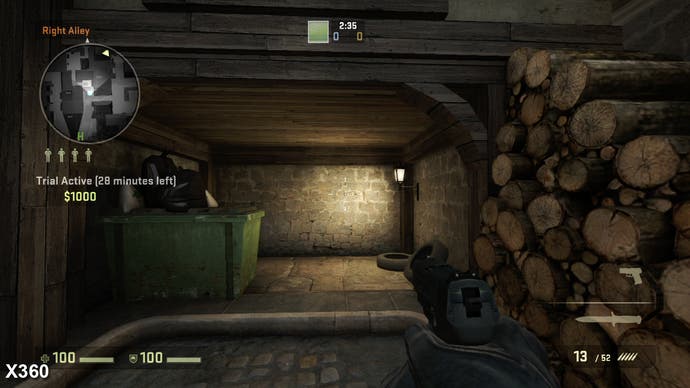
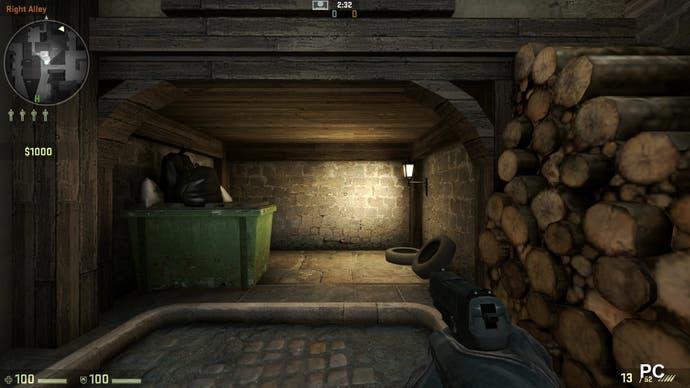

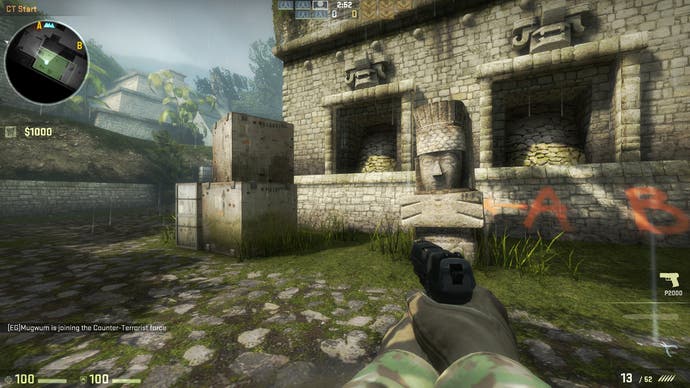
Indeed, astonishingly, in our testing, we found areas of the PC game which actually feature lower resolution assets than the console games. Road signs, walls, and posters in various maps seem to vary wildly in quality, with some areas benefiting from much higher quality artwork than others. Remarkably, the quality of the artwork used on some of these surfaces is a noticeable step down from what we are seeing on the consoles. A good example can be seen in the shots below.
Take a look at the posters on the wall located in the Dust map. On the PS3 and 360 the information is visible, if rather blurred. But on the PC it simply appears as an unsightly pixelated mess. We're not entirely sure why this is happening: we even double checked our settings to ensure we had everything set to maximum, in case of human error, but there was nothing out of place that we could find: a bug peculiar to our set-up? The situation is made even more obvious when running the game in resolution higher than 720p, where it's easier to distinguish between high and low resolution textures.
On the plus side, the use of 16x anisotropic filtering (over what looks like 8x on consoles) ensures that texture detail does stay clearer for longer distances, with intricate markings contained within the artwork being visible from further away from the camera. However, there are also times where the upgrades are limited in this regard, and where the added boost in filtering only delivers minor improvements in clarity - since the consoles are already using a high level of AF, the added jump to 16x sometimes only delivers marginally better results. Image quality is also boosted when running the game in 1080p, with the already excellent MSAA plus FXAA combo working even better with the added pixel precision on offer with a higher resolution framebuffer.
"More advanced GPU hardware allows the Source Engine to operate with higher precision effects, plus the option is there for both multi-sample and post-process anti-aliasing."
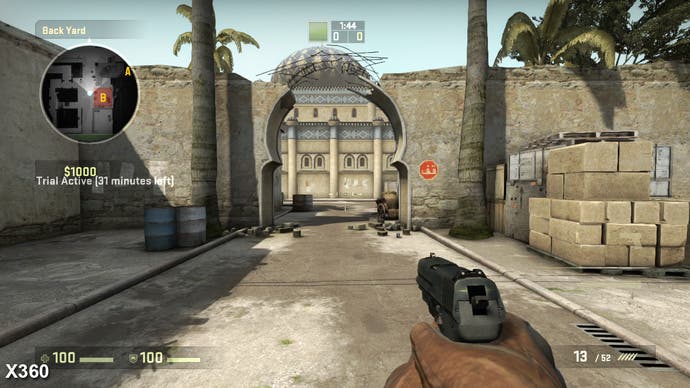
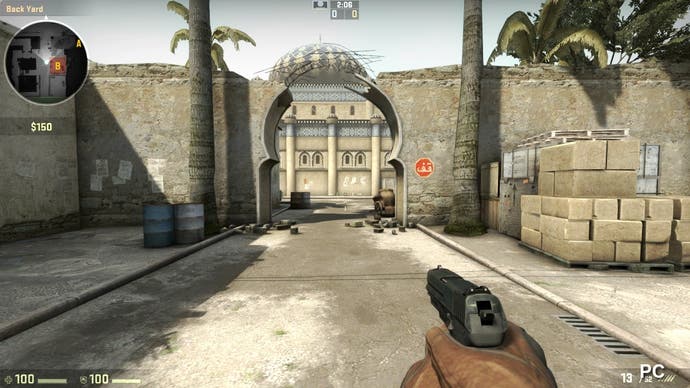
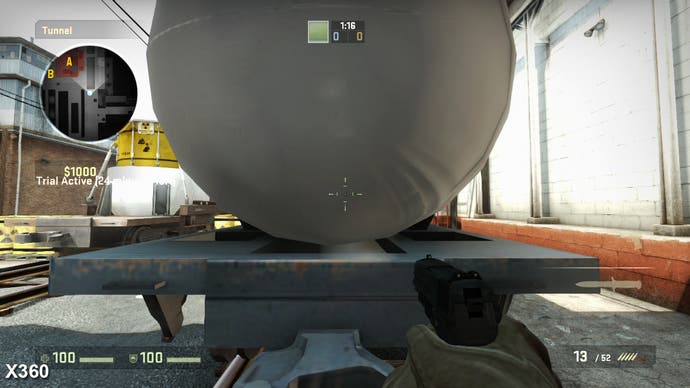
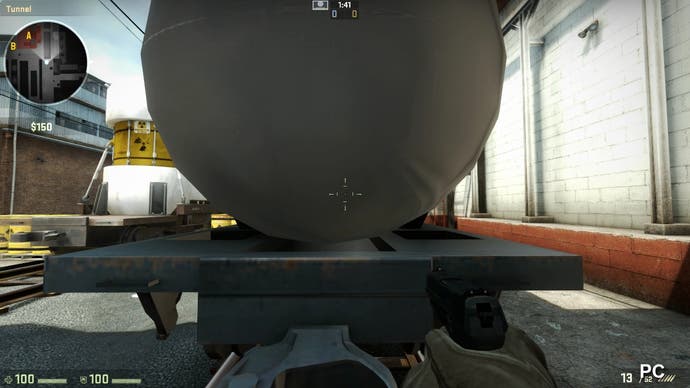
Elsewhere PC owners get a number of higher precision effects which give the game a more refined look over the console counterparts: camera motion blur preserves more detail than on the 360 and PS3 while delivering a much cleaner screen distortion effect, and the enhanced water surface shaders add an extra layer of murkiness to the pools of stagnant water in the Aztec stage.
Smoke effects feature an extra layer of debris during explosions, and fire effects are more detailed. Higher precision lighting is also in play, delivering more detail in bright areas of the game whilst expanding the dynamic range on offer. Light shafts are also present, but appear more subtle in nature with the rays mildly blending in with the rest of the game's lighting components.
Shadow resolution is visibly higher than on consoles too, and this results in a reduction in the amount of stair-step edge artifacts we see when these elements are viewed from certain angles. The higher resolution nature of the shadows helps to combat the effects of PCF filtering quite nicely. In addition shadow maps (along with the rest of the game's artwork) are all completely loaded into memory so there are no visible LOD transitions at all in the PC game. The level of quality with regards to the game's assets stays the same throughout, bar the odd times when lower resolution textures are permanently used in some scenes.
"The improved rendering options in the PC version are obviously welcome, but it's the higher frame-rates in combination with keyboard and mouse control that provide the definitive experience."



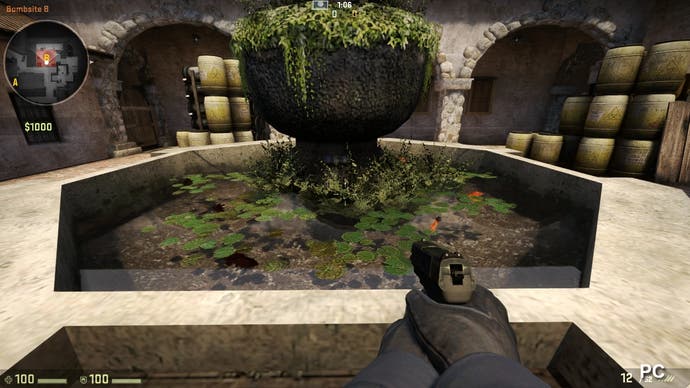
So, the upgrades here aren't particularly game-changing, with the improved image quality being the most notable enhancement the PC release of Global Offensive has over the consoles, due to the ability to lay on higher levels of anti-aliasing. The other is with regards to frame-rate. Global Offensive is hardly what you'd call a demanding game, and it is possible to run the title with all settings dialled up fully without impacting upon performance on mid-range systems. We had no issues getting a locked 1080p60 experience on our Core i5 and GTX460 set-up, while abandoning v-sync gives us between 80-115FPS across a general run of play. In addition, our £300 Digital Foundry gaming PC, featuring a dual core Intel CPU and a Radeon HD 6770 also delivers a highly satisfactory experience that once again outstrips what you can expect to get from the consoles.
In theory the ability to run at extremely high frame-rates should provide us with some extremely responsive controls. Titles such as Call Of Duty operate with around 50ms latency between button presses and the action appearing on screen, while we usually see between 100 to 133ms with games running at 30FPS. As we've already seen, the console versions of Global Offensive are quite disappointing in this regard, running with higher levels of latency than the most responsive 30FPS titles - such as Halo 3, which features a 100ms response time. But what kind of improvement do we gain on the PC?
The ability to run Global Offensive at a locked 60FPS has tangible benefits over the consoles: controls feel noticeably more responsive and the action appears buttery smooth on screen. However, there also a sense that we aren't seeing as quick controller response times as in other leading FPS titles running at the same frame-rate. With triple buffered v-sync enabled we measured a disappointing 116ms of lag between button presses and animation changes on screen, and around 100ms using the more traditional double buffered approach - essentially in line with some of the fastest 30FPS titles, but far less responsive than the likes of Call Of Duty and Borderlands when running at 60FPS, which both feature just 50ms latency.
Pro players ditch v-sync in order to maximise frames and reduce controller latency to the lowest possible levels, the trade off being image consistency is lost as lost of torn frames appear on screen. Switching off v-sync in Global Offensive brought about a major improvement: button presses and movements of the analogue sticks felt far more responsive, perhaps being more along the lines we first expected from a shooter of this type. Performance metrics reveal consistent 50ms latency figures when running at 115 frames per second - in itself a good result, but disappointing when you consider that we got exactly the same result from Borderlands on PC, with v-sync engaged and frame-rate locked at 60.
Counter-Strike: Global Offensive - The Digital Foundry Verdict
The quality of the conversion across multiple platforms is decent, but not completely free from issues. While the core gameplay experience remains wholly intact, it varies across both console formats. The 360 release features more stable performance, higher precision water effects and additional shaders, while on the PS3 the lighting model appears to be closer to the PC game, with extra light sources in play over the 360 version in many areas.
Performance on Sony's system is also visibly less stable. Dips in frame-rate impact gameplay, and tearing is regularly intrusive, often manifesting after the trigger has been pulled - even in small fire fights without too much going on elsewhere. Aiming and tracking doesn't feel quite as intuitive as it should, and the fundamental interface between the player and the game clearly isn't all it could've been. It's not great on Xbox 360, but it's noticeably worse on the PlayStation 3. Here's where the added mouse and keyboard support can make a difference.
With this in mind, when it comes down to competitive console play, there's a sense that the 360 version's more stable frame-rate makes it the better of the two games, despite the fact that the lighting and gamma changes result in a less vibrant looking game that doesn't match the PC release quite as closely as the PS3 version. The reduced level of latency during gunfights makes it easier to track and take down enemies with fewer shots, while the lack of choice with regards to control set-up ensures that everyone is on a level playing field.
"Well worth buying on all systems - even now, Counter-Strike still feels fresh despite the basic formula not being altered for the best part of a decade."
Of course, Global Offensive reigns supreme on the PC - the format it was conceived on, and specifically designed around. Visually, the graphical upgrades on offer aren't likely to blow you away coming from the console releases, although the extra clarity and sub-pixel detail provided by the use of higher resolution textures and better anti-aliasing still delivers a tangible bump in quality over the 360 and PS3 ports. The inclusion of some awfully low resolution assets is disappointing though, with some textures looking worse than on console. But thankfully the bulk of the artwork is superior, with some surfaces featuring a higher level of detail.
Where the PC release gains a big advantage is with regards to how well it plays when being paired up with modest hardware. Higher frame-rates combined with traditional mouse and keyboard inputs allow for controller response times to be much, much quicker than on the consoles - as long as you turn v-sync off it is possible to achieve fast, low latency controls. Although response times are disappointingly lower than found in competing twitch-based shooters. Both double and triple buffering options introduce a sizeable amount of latency, with frame-rates of 60FPS delivering 30FPS standard response times.
Overall, Counter-Strike: Global Offensive is well worth buying on both consoles for those looking for a different take on the online first-person shooter: the game still feels remarkably fresh despite the basic formula and gameplay not being altered for the best part of a decade, although for those interested in more serious tournament play the 360 version gets the nod here due to being the more reliable performer. Given the choice though, the PC version is really the best version to get. It's easy to run on a wide range of hardware configurations and allows for blisteringly high frame-rates, delivering a much more satisfying gameplay experience than either of the current-gen consoles.
